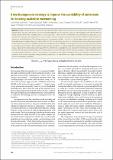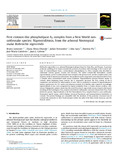Buscar
Mostrando ítems 21-30 de 79
Venomic analysis of the poorly studied desert coral snake, Micrurus tschudii tschudii, supports the 3FTx/PLA2 dichotomy across Micrurus venoms
(2016)
The venom proteome of the poorly studied desert coral snake Micrurus tschudii tschudii
was unveiled using a venomic approach, which identified ¥38 proteins belonging to only four snake
venom protein families. The ...
Half a century of research on Bothrops asper venom variation: biological and biomedical implications
(2022)
Snake venoms are a complex biological mixture of proteins with or without enzymatic activity, peptides, and nucleotides, among other components. It is produced in specialized secretory glands located in the maxillary region, ...
The Need for Full Integration of Snakebite Envenoming within a Global Strategy to Combat the Neglected Tropical Diseases: The Way Forward
(2013-06-13)
Snakebite envenoming constitutes a serious medical condition that primarily affects residents of rural communities in Africa, Asia, Latin America, and New Guinea [1], [2]. It is an occupational, environmental, and domestic ...
Immunological profile of antivenoms: preclinical analysis of the efficacy of a polyspecific antivenom through antivenomics and neutralization assays
(En prensa, 2014-02-28)
Parenteral administration of animal-derived antivenoms constitutes the mainstay in the
treatment of snakebite envenomings. Despite the fact that this therapy has been available for over a century, the detailed understanding ...
A multicomponent strategy to improve the availability of antivenom for treating snakebite envenoming
Una estrategia multicomponente para mejorar la disponibilidad del suero antiofídico para el tratamiento del envenenamiento por mordedura de serpiente
(2014-07-01)
Snakebite envenoming is a common but neglected public health problem, particularly in impoverished rural regions of sub-Saharan Africa, Asia and Latin America. The only validated treatment for this condition is passive ...
Two color morphs of the pelagic yellow-bellied sea snake, pelamis platura, from different locations of Costa Rica: snake venomics, toxicity, and neutralization by antivenom
(Journal of Proteomics Volume 103, 30 May 2014, Pages 137–152, 2014-05-30)
The yellow-bellied sea snake, Pelamis platura, is the most broadly distributed snake species. Despite being endowed with a highly lethal venom, a proteomic analysis of its toxin composition was unavailable. The venoms of ...
New approaches & technologies of venomics to meet the challenge of human envenoming by snakebites in India
(2013-07)
The direct estimate of 46,000 snakebite deaths in India in 2005 (1 for every 2 HIV/AIDS deaths), based on verbal autopsies, renders unrealistic the total of only 47,000 snakebite deaths in the whole world in 2010, obtained ...
First crotoxin-like phospholipase A2 complex from a New World non-rattlesnake species: Nigroviriditoxin, from the arboreal Neotropical snake Bothriechis nigroviridis
(Toxicon vol 93:144–154, 2015-01)
Bothriechis nigroviridis is an arboreal Neotropical pitviper found in Costa Rica and Panam a. A previous
proteomic profiling of its venom revealed the presence of proteins with homology to the A and B subunits
of ...
Preclinical assessment of a polyspecific antivenom against the venoms of Cerrophidion sasai, Porthidium nasutum and Porthidium ophryomegas: Insights from combined antivenomics and neutralization assays
(2013-03-15)
A polyspecific antivenom is used in Central America for the treatment of envenomings by viperid snakes. This antivenom is generated in horses hyperimmunized with a mixture of venoms from Bothrops asper, Crotalus simus and ...
Combined venomics, venom gland transcriptomics, bioactivities, and antivenomics of two Bothrops jararaca populations from geographic isolated regions within the Brazilian Atlantic rainforest
(2016-03-01)
Bothrops jararaca is a slender and semi-arboreal medically relevant pit viper species endemic to tropical and subtropical forests in southern Brazil, Paraguay, and northern Argentina (Misiones). Within its geographic range, ...








